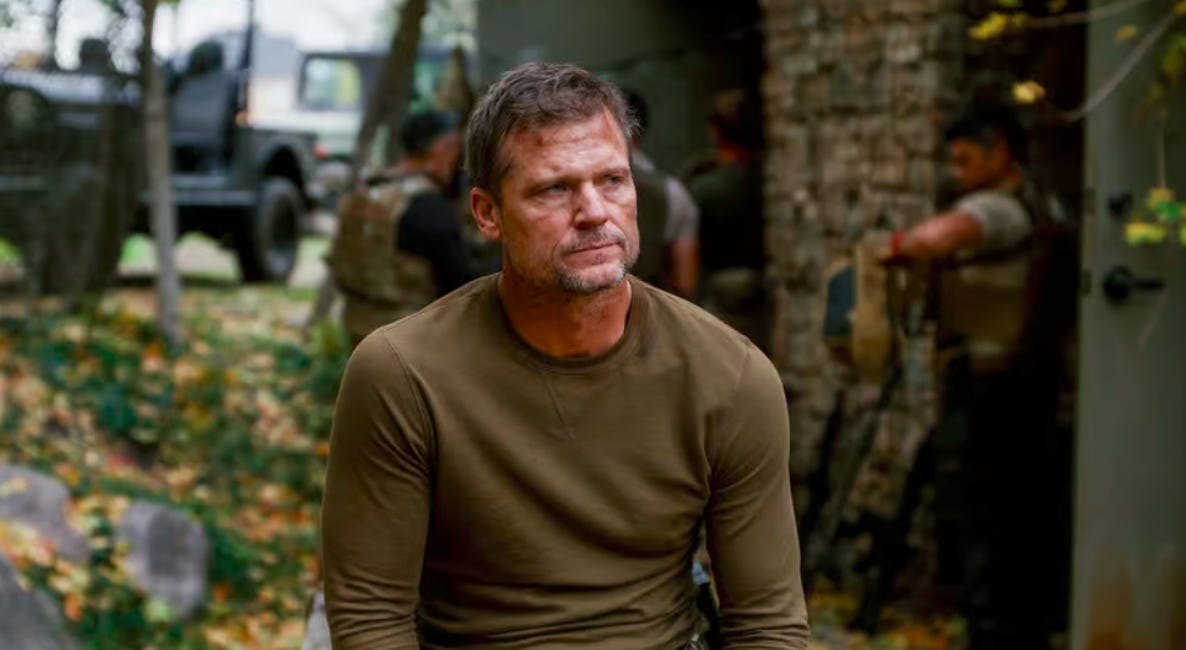My friend’s eyes got wide as he asked, “You haven’t seen Firefly?”
If you’ve never heard of Firefly, it was a short-lived show that Fox canceled in the days when we still defended President Bush and American Idol was celebrating amateur talent. Firefly was notable then for being unique, and it’s notable now for many attributes, including how to write a girl boss properly. Disney and Amazon Prime have turned female heroes into cringe parodies almost every time they’ve tried it. If we’re gonna revitalize the creative soil they’ve polluted, writers need to learn how to do it well again.
Until about three months ago I hadn’t seen Firefly, although I’d heard many a Sci-fi nerd rave about it. Firefly was sort of an A-Team in space with a western feel, often incorporating six-shooters and horses with laser weapons and intergalactic travel. It sounds weird but it works, and you’ll just have to trust me on that until you see it.
It’s not a perfect show; there are a few tropes I don’t jive with, like the benevolent prostitute, the preacher who never mentions Jesus, and the will they/won’t they lead character love trope. But overall it did most things well, and some things better than anyone is doing currently.
The Modern Girl Boss
I don’t have a problem with girl bosses. In fact, if I think back to my former life working for one of the largest multi-national corporations on Earth, I’d say most of the best managers I had over those twenty years were women. But in the realm of writing fiction, girl boss has become a pejorative, and with good reason.
Large studios and streaming services have been cramming cash into the DEI meat grinder and their writers have been oozing out unrealistic, often insufferable female characters as rapidly and frequently as a factory of Chinese slaves can whip out any other Amazon product.
It’s left a wasteland of male heroes in the wake of every IP they’ve absorbed, from Star Wars to the Tom Clancy cinematic universe—they transformed Admiral Greer into a thirty-year-old black woman1, for crying out loud—and it’s going to take some ingenuity to reestablish that, yes, women can make compelling leaders, and no, they don’t have to do all of the man things to achieve it. Forget the nonsense of a 100-pound Millennial choking out guys three times her size; we can write this better.
Let’s begin by taking a look at a show that got it right.
The Damsel In Distress/Girl Boss Dichotomy
There are several prominent female characters in Firefly but the one most fitting the definition of girl boss is Zoe. As unofficial second-in-command, she’s fearless, intelligent, no nonsense, and great with a gun…lots of guns, in fact. All of this works because of her background; she was a battle hardened veteran soldier on the losing side of an intergalactic war. She went through hell and came out alive alongside the show’s lead, Malcolm.
Zoe is age-appropriate for the role, feminine, loves her husband, makes hard sacrifices on his behalf and expresses a desire to begin a family, all without losing her focus as new challenges occur.
In some ways, the opposite of Zoe is Kaylee. She’s young, often starry-eyed, gentle, and desires all of the things a twenty-something adventuring away from home for the first time wants: to be loved, have genuine companionship from those who respect her, and feel useful in an environment full of people smarter and more experienced than her.
But in other ways Kaylee is also kinda boss herself in a traditionally male dominant role. She’s a brilliant mechanic and gets the crew out of binds periodically, but—and this is where Firefly succeeds where other shows fail—not always. Sometimes she can’t just fix it. Sometimes she screws up and has to be rescued. They all do.
In one episode, Kaylee longs for a fancy dress she can’t afford and has no practical use for. After insulting her, Malcolm (spurred on by Zoe) ends up buying it for her and even manages to give her an opportunity to enjoy wearing it. It’s a tender gesture that adds tremendous depth to three characters, and all the more impressive given the genre.
Girl boss though she may be, Zoe sometimes fails as well. Usually when that happens, it’s only sheer luck or substantive teamwork that saves her bacon.
Perhaps the best example of this nuance between damsel in distress versus girl boss is displayed in an episode where the crew needs to infiltrate a heavily fortified ship and initiate a rescue.
Zoe goes in, but not before handing Kaylee a gun and imploring her to hold a position at all costs. A modern scriptwriter would have made this Kaylee’s grand moment to go full Black Widow and save the day, maybe grappling with a guy and punching someone out. Instead, true to character, Kaylee never even gets a shot off. She is so overwhelmed in the battle that she freezes and almost gets everyone killed. It’s a moment grounded in reality, and far from making us angry at Kaylee, we empathize with her. She’s not a soldier, it’s not her gifting, and she shouldn’t be there on the front lines.
We the viewer (or reader) need more scenes like this. We need to be reminded that battles are ugly and not everyone is cut out for them.
Strong Women Don’t Just Kick A**
Somehow, writers have swung the pendulum of female hero so far to the girl boss side that we no longer expect women to do normal women things in literature or film. If Pride and Prejudice were written today for modern audiences, Elizabeth Bennett would never cry ugly tears in front of Darcy. She’d bottle that emotion up the second she read her sister’s letter. She probably would have issued some declaration eschewing outdated notions of aristocratic propriety and carried on as a proud and volatile spinster. Darcy never would have been given the opportunity to serve her, secretly or otherwise, and the realistic things we generally long for—love and security—would have been tossed on the rubbish heap.
Jane Eyre wouldn’t have fled to an uncertain future when confronted with a wacko first wife. More likely they would have had Jane just sleep with him anyway, because morality isn’t exactly a virtue in popular fiction these days, much less monogamy.
It may be surprising to learn, but out of the best female characters in literature and film (and I suppose we should increasingly add video games in this, as well), most had to be rescued at some point, sometimes multiple times: Lizzy Bennett, Jane Eyre, Scarlett O’Hara, Lara Croft, Hermione Granger, Princess Leia, Katniss Everdeen, Éowyn…the list goes on and on. Even the grandmamma of all female bad**es, Ellen Ripley, had to be rescued by men at least three times in the movies that didn’t suck.2
But do you know who else needed rescuing more than once? Luke Skywalker, Jack Ryan, Robinson Crusoe, Ding Chavez, Frodo Baggins, Batman, Indiana Jones, Charles Xavier…and a ton of other men.
That’s okay, because in real life both men and women routinely need rescued. Such is the nature of action stories and great drama. If our stories are going to do what we want them to do—entertain—then the fantastic worlds we create have to be grounded in universal truths, things we understand innately: human frailty, realistic emotions, proper physics, and logical motivations.
We need to imagine what an ordinary person might feel, say, or do in that situation we’ve concocted. If we do so in a manner consistent with reality, with fear and determination and the assemblage of human emotions in play, we can toss in all the orcs or space aliens we want. They’re just background noise to accentuate the actual story we’re trying to tell. Far from relying on Supernatural Girl Bossery, we can have our heroine (or hero) fail or cower in fear in the beginning of her journey. It might make a great scene, and might set up a payback in an even better sequel.
As writers, we’re given the task of creating out of thin air stories that move people. In order to do that, and do it well, we need to recognize what it is that makes an audience connect with a character: authenticity, realism, and truth.
You can follow me on Telegram, Substack, Truth Social, GETTR, Gab, and X.
If you enjoy my work, please consider supporting us with a paid subscription in the amount of your choice. Or if you’d like to make a one time donation feel free to Buy Me A Coffee. You can subscribe to receive new posts to your inbox for free, as well as get information on my upcoming books and projects.
If you enjoyed this article, you may enjoy these as well:
Debating the True Mount Sinai, and Why it Matters
Apparently there’s a heated debate within the Biblical archaeology community about the location of Mount Sinai—where the Israelites camped after fleeing Egypt, and where Moses received the Ten Commandments and instructions for the tabernacle. Some say it’s on the Sinai peninsula, others argue it’s actually in Saudi Arabia. The available data includes ce…
Writing Matters: Homestead & How To Fix Cringy Content
“Christian cringey”is a term my wife and I use to describe the lackluster creative content our side has put out for decades. All writers need to understand what makes great stories take flight, and what causes them to crash and burn on take-off. If you’re a creative writer, this post will serve as reminder of what works versus what doesn’t, what could w…
Exploring The History Of Women In Leadership
There are plenty of legitimate reasons why Kamala Harris is unqualified to be President of the United States, but I was taken aback recently by those who disqualify her from leadership because she’s a woman.








The creator of Firefly, Josh Weldon was a typical male feminist, he was a dreadful misogynistic abusive pig.
There are plenty of man who claim to ne feminists when they are abusers of women.
They use the, "I'm a male feminist", to get themselves out of trouble.
Harvey Weinstein being a perfect example.